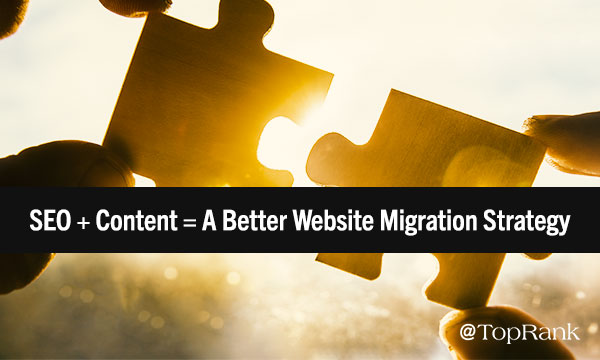But SEO can’t stand alone—it needs a content lens to ensure a solid performance after the switch is flipped. Better Together: Content + SEO for Migration Success A poorly planned and executed migration after a site refresh or redesign can lead to decreases in organic traffic and reduced search visibility in both the short- and long-term. By baking content and SEO into your website migration strategy, you have the opportunity to: #1 – Strike that oh-so-necessary balance between SEO and user experience. The key is integration from the start. From there, strategic content tweaks can be made with both SEO and user experience in mind before launch. - @Alexis5484 Click To Tweet Read: How to Use Google Search Console to Increase SEO Visibility #3 – Promote your new and improved site. You’ll also need to make sure your site map is updated in Google Search Console if any URL structures have changed. You need context and insight—some of which can be drawn from the competitive content landscape—in order to make strategic content updates that better answer your audience’s questions, as well as send positive signals to search engines. Integration = More Successful Migration There’s little doubt that SEO needs be at the forefront of any website redesign and subsequent migration. By pairing content and SEO together, you can make more thoughtful and strategic decisions that will help you bolster user experience as well as search visibility.

Digital marketers know their company’s website is more than a digital storefront. It’s a marketplace that must deliver a quality, engaging experience for prospects and customers once they arrive. So, it’s no surprise that the average company invests in a website redesign every three years to stay fresh, competitive, and meet evolving customer expectations.
In our experience, however, design faux pas aren’t the biggest marketing missteps that can lead to poor results after a migration—it’s the lack of a solid website migration strategy that encompasses both SEO and content considerations.
There’s no question that SEO needs to play a leading role in the planning, design, and execution of any website migration. But SEO can’t stand alone—it needs a content lens to ensure a solid performance after the switch is flipped.
Better Together: Content + SEO for Migration Success
A poorly planned and executed migration after a site refresh or redesign can lead to decreases in organic traffic and reduced search visibility in both the short- and long-term. And chances are, your marketing team has spent innumerable hours crafting content and optimizing your site for both user experience and search engine performance—and you don’t want it all to be for naught.
By baking content and SEO into your website migration strategy, you have the opportunity to:
#1 – Strike that oh-so-necessary balance between SEO and user experience.
If you’re embarking on a website redesign, chances are your goals are to improve user experience and optimize conversions paths, all while strengthening your organic search footprint. But without SEO and content working together, the steps you take to reach those goals can’t be fully informed or reach their full potential. The key is integration from the start.
#2 – Bolster top performing content (and weed out weak or irrelevant content).
Site migrations often involve some picking and choosing as far as what content needs to be kept,…

COMMENTS